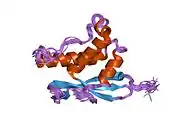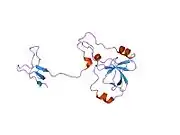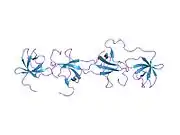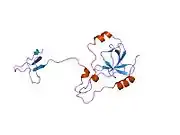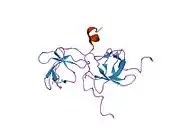Neutrophil cytosolic factor 1
Neutrophil cytosol factor 1, also known as p47phox, is a protein that in humans is encoded by the NCF1 gene.[5]
Function
The protein encoded by this gene is a 47 kDa cytosolic subunit of neutrophil NADPH oxidase. This oxidase is a multicomponent enzyme that is activated to produce superoxide anion. Mutations in this gene have been associated with chronic granulomatous disease.[5]
Genetic variability in the NCF1 gene has been found to be related to a higher chance of getting autoimmune diseases such as Sjögren's syndrome, rheumatoid arthritis and lupus erythematosus.[6]
Interactions
Neutrophil cytosolic factor 1 has been shown to interact with:
References
- GRCh38: Ensembl release 89: ENSG00000158517 - Ensembl, May 2017
- GRCm38: Ensembl release 89: ENSMUSG00000015950 - Ensembl, May 2017
- "Human PubMed Reference:". National Center for Biotechnology Information, U.S. National Library of Medicine.
- "Mouse PubMed Reference:". National Center for Biotechnology Information, U.S. National Library of Medicine.
- "Entrez Gene: NCF1 neutrophil cytosolic factor 1, (chronic granulomatous disease, autosomal 1)".
- "Study of complex genetic region finds hidden role of NCF1 in multiple autoimmune diseases". Medical Express. 2017-02-08. Retrieved 2017-02-09.
- Wientjes FB, Reeves EP, Soskic V, Furthmayr H, Segal AW (Nov 2001). "The NADPH oxidase components p47(phox) and p40(phox) bind to moesin through their PX domain". Biochem. Biophys. Res. Commun. 289 (2): 382–8. doi:10.1006/bbrc.2001.5982. PMID 11716484.
- Lapouge K, Smith SJ, Groemping Y, Rittinger K (Mar 2002). "Architecture of the p40-p47-p67phox complex in the resting state of the NADPH oxidase. A central role for p67phox". J. Biol. Chem. 277 (12): 10121–8. doi:10.1074/jbc.M112065200. PMID 11796733.
- Grizot S, Grandvaux N, Fieschi F, Fauré J, Massenet C, Andrieu JP, Fuchs A, Vignais PV, Timmins PA, Dagher MC, Pebay-Peyroula E (Mar 2001). "Small angle neutron scattering and gel filtration analyses of neutrophil NADPH oxidase cytosolic factors highlight the role of the C-terminal end of p47phox in the association with p40phox". Biochemistry. 40 (10): 3127–33. doi:10.1021/bi0028439. PMID 11258927.
- Sathyamoorthy M, de Mendez I, Adams AG, Leto TL (Apr 1997). "p40(phox) down-regulates NADPH oxidase activity through interactions with its SH3 domain". J. Biol. Chem. 272 (14): 9141–6. doi:10.1074/jbc.272.14.9141. PMID 9083043.
- Gu Y, Xu YC, Wu RF, Nwariaku FE, Souza RF, Flores SC, Terada LS (May 2003). "p47phox participates in activation of RelA in endothelial cells". J. Biol. Chem. 278 (19): 17210–7. doi:10.1074/jbc.M210314200. PMID 12618429.
Further reading
- Dorseuil O, Gacon G (1997). "[Signal transduction by Rac small G proteins in phagocytes]". C. R. Séances Soc. Biol. Fil. 191 (2): 237–46. PMID 9255350.
- Casimir CM, Bu-Ghanim HN, Rodaway AR, Bentley DL, Rowe P, Segal AW (1991). "Autosomal recessive chronic granulomatous disease caused by deletion at a dinucleotide repeat". Proc. Natl. Acad. Sci. U.S.A. 88 (7): 2753–7. doi:10.1073/pnas.88.7.2753. PMC 51317. PMID 2011585.
- Rodaway AR, Teahan CG, Casimir CM, Segal AW, Bentley DL (1990). "Characterization of the 47-kilodalton autosomal chronic granulomatous disease protein: tissue-specific expression and transcriptional control by retinoic acid". Mol. Cell. Biol. 10 (10): 5388–96. doi:10.1128/mcb.10.10.5388. PMC 361238. PMID 2398896.
- Lomax KJ, Leto TL, Nunoi H, Gallin JI, Malech HL (1989). "Recombinant 47-kilodalton cytosol factor restores NADPH oxidase in chronic granulomatous disease". Science. 245 (4916): 409–12. doi:10.1126/science.2547247. PMID 2547247.
- Volpp BD, Nauseef WM, Donelson JE, Moser DR, Clark RA (1989). "Cloning of the cDNA and functional expression of the 47-kilodalton cytosolic component of human neutrophil respiratory burst oxidase". Proc. Natl. Acad. Sci. U.S.A. 86 (18): 7195–9. doi:10.1073/pnas.86.18.7195. PMC 298023. PMID 2550933.
- Volpp BD, Nauseef WM, Clark RA (1988). "Two cytosolic neutrophil oxidase components absent in autosomal chronic granulomatous disease". Science. 242 (4883): 1295–7. doi:10.1126/science.2848318. PMID 2848318.
- Miki Y, Swensen J, Shattuck-Eidens D, Futreal PA, Harshman K, Tavtigian S, Liu Q, Cochran C, Bennett LM, Ding W (1994). "A strong candidate for the breast and ovarian cancer susceptibility gene BRCA1". Science. 266 (5182): 66–71. doi:10.1126/science.7545954. PMID 7545954.
- Leto TL, Adams AG, de Mendez I (1994). "Assembly of the phagocyte NADPH oxidase: binding of Src homology 3 domains to proline-rich targets". Proc. Natl. Acad. Sci. U.S.A. 91 (22): 10650–4. doi:10.1073/pnas.91.22.10650. PMC 45079. PMID 7938008.
- el Benna J, Faust LP, Babior BM (1994). "The phosphorylation of the respiratory burst oxidase component p47phox during neutrophil activation. Phosphorylation of sites recognized by protein kinase C and by proline-directed kinases". J. Biol. Chem. 269 (38): 23431–6. doi:10.1016/S0021-9258(17)31534-X. PMID 8089108.
- Maruyama K, Sugano S (1994). "Oligo-capping: a simple method to replace the cap structure of eukaryotic mRNAs with oligoribonucleotides". Gene. 138 (1–2): 171–4. doi:10.1016/0378-1119(94)90802-8. PMID 8125298.
- Finan PM, Hall A, Kellie S (1996). "Sam68 from an immortalised B-cell line associates with a subset of SH3 domains". FEBS Lett. 389 (2): 141–4. doi:10.1016/0014-5793(96)00552-2. PMID 8766817. S2CID 19631155.
- Sathyamoorthy M, de Mendez I, Adams AG, Leto TL (1997). "p40(phox) down-regulates NADPH oxidase activity through interactions with its SH3 domain". J. Biol. Chem. 272 (14): 9141–6. doi:10.1074/jbc.272.14.9141. PMID 9083043.
- Görlach A, Lee PL, Roesler J, Hopkins PJ, Christensen B, Green ED, Chanock SJ, Curnutte JT (1997). "A p47-phox pseudogene carries the most common mutation causing p47-phox- deficient chronic granulomatous disease". J. Clin. Invest. 100 (8): 1907–18. doi:10.1172/JCI119721. PMC 508379. PMID 9329953.
- Suzuki Y, Yoshitomo-Nakagawa K, Maruyama K, Suyama A, Sugano S (1997). "Construction and characterization of a full length-enriched and a 5'-end-enriched cDNA library". Gene. 200 (1–2): 149–56. doi:10.1016/S0378-1119(97)00411-3. PMID 9373149.
- Izuhara K, Arinobu Y, Sumimoto H, Nunoi H, Takeya R, Higuchi K, Takeshige K, Hamasaki N, Harada N (1999). "Association of the interleukin-4 receptor alpha chain with p47phox, an activator of the phagocyte NADPH oxidase in B cells". Mol. Immunol. 36 (1): 45–52. doi:10.1016/S0161-5890(98)00111-4. PMID 10369419.
- Nakamura F, Huang L, Pestonjamasp K, Luna EJ, Furthmayr H (1999). "Regulation of F-actin binding to platelet moesin in vitro by both phosphorylation of threonine 558 and polyphosphatidylinositides". Mol. Biol. Cell. 10 (8): 2669–85. doi:10.1091/mbc.10.8.2669. PMC 25498. PMID 10436021.
- Rinckel LA, Faris SL, Hitt ND, Kleinberg ME (1999). "Rac1 disrupts p67phox/p40phox binding: a novel role for Rac in NADPH oxidase activation". Biochem. Biophys. Res. Commun. 263 (1): 118–22. doi:10.1006/bbrc.1999.1334. PMID 10486263.
- Chanock SJ, Roesler J, Zhan S, Hopkins P, Lee P, Barrett DT, Christensen BL, Curnutte JT, Görlach A (2000). "Genomic structure of the human p47-phox (NCF1) gene". Blood Cells Mol. Dis. 26 (1): 37–46. doi:10.1006/bcmd.2000.0274. PMID 10772875.
- Onofri F, Giovedi S, Kao HT, Valtorta F, Bongiorno Borbone L, De Camilli P, Greengard P, Benfenati F (2000). "Specificity of the binding of synapsin I to Src homology 3 domains". J. Biol. Chem. 275 (38): 29857–67. doi:10.1074/jbc.M006018200. PMID 10899172.
This article is issued from Wikipedia. The text is licensed under Creative Commons - Attribution - Sharealike. Additional terms may apply for the media files.





